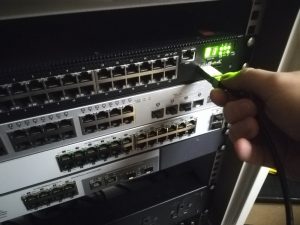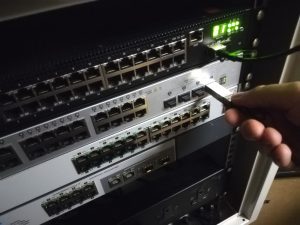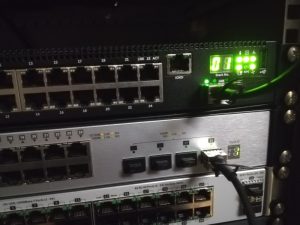It is a common requirement to connect two or more switches together that are in close proximity to each other, sometimes in the same cabinet. Usually this is done to expand the number of available ports in a location without having to run an extra dedicated link back to the network core, but this process may not be a simple as it first appears.
It is important to consider the bandwidth requirements of your switches, simply patching a Cat5e or Cat6 cable between two switches will work, but will it provide sufficient bandwidth? Chances are the switch ports are Gigabit, so you will have a maximum bandwidth of 1000Mbps between the two switches. This may be sufficient for less demanding networks with basic applications, but if you have multiple users all driving high bandwidth applications over the network such as streaming video, then this will become a significant bottleneck.
Many high end switches have built in stacking ports, a dedicated, high bandwidth channel designed specifically for connecting two or more switches to each other in one logically managed “stack”. When these ports are present it is without a doubt the best way of connecting switches together, but what about less expensive, or edge switches that don’t have stack ports? Look for SFP ports, or even better SFP+ ports for 10G connections.
If your switch only has Gigabit SFP ports then you are limited to bandwidth, but a fibre optic Gigabit link is slightly more efficient than using the copper access ports of a switch. There is also the option of trunking multiple ports for a bigger logical link with greater bandwidth – this is explained in a previous article published here.
If your switch has 10G SFP+ ports then a great new possibility is opened up to you, connecting together using low cost 10G direct attach cables, or DAC for short. These are effectively two 10G SFP+ modules and a length of cable moulded into a complete, single piece assembly that can easily plug into two switches and create an instant, high bandwidth link between them. Some switch vendors are even using this method as their primary stacking option now, and using software on the switch to manage these connected devices under a single logical management interface.



DAC cables are limited in length, up to 5meters using passive copper cable, which is the most cost efficient solution. Length above this up to 15meters can be achieved using active copper cable, which is a little more expensive but still more cost efficient than two separate SFP+ modules and a long patch cable.
Anything over this length can be achieved with an active optical cable (AOC), which is a single piece assembly again but using optical fibre between the two ends of the assembly instead of copper.
Once you have determined the best way of connecting your switches together, follow your switch manufacturer’s guidance for specific guidance to any proprietary ports such as stacking ports. If you choose to use direct attach or active optical cables, then the process is simple when using Advance branded products – simply plug and play!
